| |||||||
| Search Forums |
| Advanced Search |
| Go to Page... |
 |
| Search this Thread |  1,740,174 views |
| | #1 |
| Team-BHP Support  | Mahindra XUV300 : Official Review The Mahindra XUV300 is on sale in India at a price of between Rs. 7.90 - 11.99 lakhs. What you'll like: • A truly premium crossover. Nice build, quality & refinement levels • Great looking! Smart design has none of the usual Mahindra quirkiness • Cabin has enough space for 5. Quality-wise, the interior is more like a Hyundai • Fantastic engines. The petrol & diesel, both, offer fast performance & good driveability • A compliant ride with neutral road manners • 5-star NCAP rating & kit. 7 airbags, ESP, ABS, all-wheel disc brakes, TPMS, seatbelt reminders for all & more • Loaded to the gills with equipment (front parking sensors, sunroof, cruise control, auto headlamps & wipers etc) What you won't: • The most expensive Compact SUV in India! Not overpriced, but definitely higher than expected • 257-liter boot is the smallest in the segment. There are cheaper hatchbacks which have a larger boot • Concerns over niggles in a freshly baked Mahindra. Our test car itself had issues • Lack of a proper middle variant. W6 trim is simply too bare-bones, while W8 is expensive! • No automatic option in a market that is moving toward ATs • Mahindra's after-sales service quality is a hit or miss. Remains a gamble • Some important features missing (dead pedal, parcel tray, rear air-con, steering reach adjustment etc) The 2021 1.2L Petrol Automatic (AMT) • Link to Review Last edited by Aditya : 6th February 2021 at 14:58. Reason: Petrol AMT review link added |
| |  (87)
Thanks (87)
Thanks
|
| The following 87 BHPians Thank Aditya for this useful post: | 2himanshu, abhinav.s, AdityaDeane, Aditya_Bhp, Alfresco, aniyo, arbaz906, artemis_fowl, asingh1977, AutoIndian, autoskooll, Avikbrio, black.beauty, BlackPearl, carrazy, ChiragM, Chrome6Boy, CrAzY dRiVeR, dailydriver, darklord, deehunk, DevilzzzzOwn, Dr.AD, espraveen, Fastdriver, Flyer, freak, FrodoOfTheShire, ganeshb, GKMahajan, GTO, haisaikat, hmansari, Illuminati, InControl, johannskaria, JoseVijay, Keynote, kubectl, lemedico, Leoshashi, LoneRidder, low_range, Malabari, MandarG, mbz180, mi2n, mohansrides, N33raj, neil.jericho, Nitish B Shetty, Nohonking, Omkar, PapaKiloSierra9, pavi, PGA, phoenixash, PrasunBannerjee, RaghuVis, rajvardhanraje, Rambo-RS, ramnaresh_2000, RavenAvi, S.MJet, SaiSW, Samurai, sandeepmdas, sayakc, Simat, Simhi, stormdRider, Sugato, suhaas307, sukiwa, Sumer, sunny29584, swiftnfurious, theexperthand, Thermodynamics, The_Outsider!, TusharK, uday.ere, vaasu, Varun_HexaGuy, vb-saan, VTec_KickedInYo, WhiteFang |
| |
| | #2 |
| Team-BHP Support  | Review Index: Exterior Last edited by GTO : 15th April 2019 at 10:07. |
| |  (17)
Thanks (17)
Thanks
|
| The following 17 BHPians Thank Aditya for this useful post: | abhinav.s, Avikbrio, CrAzY dRiVeR, DevilzzzzOwn, GTO, hmansari, JoseVijay, Malabari, phoenixash, RavenAvi, Scorpion 10, Simat, Sparrow, theexperthand, uday.ere, vb-saan, VTec_KickedInYo |
| | #3 |
| Team-BHP Support  | Exterior  Our early 2019 sales charts reveal that seven out of the ten top sellers in the C2 segment are either SUVs or crossovers! Maruti's Vitara Brezza has been a regular visitor on the top 10 cars list of the country. The Ford EcoSport is a good performer too, as are the Honda WR-V & Tata Nexon. Mahindra has had presence in the 10-lakh SUV space too. However, their vehicles have all been old-school SUVs with body-on-frame constructions. This limited their appeal, as most urban buyers today prefer more modern monocoque-based crossovers which are car-like to drive. The XUV300, which is based on the SsangYong Tivoli, will be the company's first C2 segment SUV with a monocoque construction. The most important job for Mahindra was to chop the rear & bring the car's length to under 4-meters for tax savings. SsangYong has sold more than 2,60,000 units of the Tivoli in more than 50 countries since its launch in 2015. By the look of things, the XUV300 seems to have started off well too. Our sales chart shows that Mahindra sold 4,484 & 4,742 units of the car in the initial 2 months of production. Because it's based on the Tivoli, Mahindra saved big bucks in bringing the car here, as compared to developing a car from the ground up. We wish that Mahindra had done an "XUV500" with the pricing. When the XUV500 was launched, it was priced so well that the market response exceeded all expectations! With the XUV300, no one will say that. As the most expensive Compact SUV in the segment, most people feel that it's premium-priced, while some BHPians even feel that it's overpriced. Fit & finish are better than other Mahindra vehicles – in fact, they are among the best in this segment. The car is solidly built with 68% high strength steel in its construction and the doors, tailgate and bonnet have a good deal of weight to them. There's barely any flex if you press the door metal with your thumb. The vehicle's kerb weight of 1,296 kg for the petrol and 1,360 kg for the diesel makes it heavier than all other monocoque sub-4 meter rivals...and even some larger ones like the Creta! The paint quality is as good as we’ve seen in the segment.  To power the XUV300, Mahindra have used the 1.5L, 4-cylinder turbocharged diesel that was first seen in the Marazzo. A 1.2L, 3-cylinder turbocharged petrol is also available. Both powerplants are mated to a 6-speed manual gearbox. While there is no automatic option on offer at the moment, an AMT is expected in the short-term. Some rumours insist that a proper torque-converter AT is planned for later. Coming to safety, the XUV300 is equipped with dual front airbags, ABS + EBD, ISOFIX child seat mounts, impact-sensitive door locks and all-round disc brakes as standard. The top variant also gets 7 airbags, 3-point seatbelts for all seats, front parking sensors and seatbelt reminders for the rear seat! Mahindra has not equipped the car with an audible speed warning (yet). However, you do get a visual warning on the instrument cluster, albeit at a speed no one is expected to drive at. Additionally, you get TPMS, tyre position display and a reversing camera. While the XUV300 has not been crash tested by independent entities like the NCAP, the SsangYong Tivoli got a Grade 1 (highest) safety award in the 2015 KNCAP (Korean New Car Assessment Program) test. It also obtained a 4-star rating in crash tests conducted by the Euro NCAP in 2016. Anand Mahindra had publicly congratulated Tata for the Nexon's 5-star safety rating & we think Mahindra will be gunning for the same with the XUV300. Mahindra is offering a standard warranty of 2 years / unlimited km, which can be extended to 5 years / 150,000 km. We strongly recommend this extension as brand-new Mahindras are known to have niggles in the early batches. There has already been a problem with faulty shock absorbers in this car (even our test car was affected by it!!!). Thankfully, this is one Mahindra design without any quirkiness. Slim grille flanked by projector headlamps. Prominent air dam, LED DRLs and its width give the car good road presence. Chrome is used on the grille and air dam, but somehow, doesn't appear overdone: 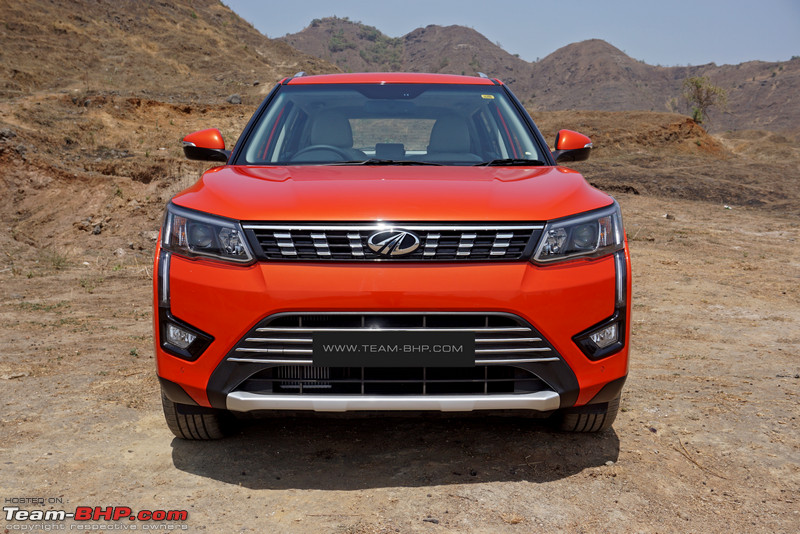 Smart rear end, but its more "hatchback" than SUV. LED tail-lamps appear to stick out from the sides. Tailgate features prominent cuts and creases. Use of chrome is limited to the badges. Exhaust pipe is barely visible. Faux skid plate is huge and adds to the character:  The XUV300 is based on SsangYong's X100 platform; while the Korean car measures more than 4 meters in length, the Mahindra has been shortened to suit the Indian market. We do get the feeling that larger bumpers could give the car a more complete look. Still, I really liked the looks & stance of the XUV300. Side body cladding, large wheels and roof rails enhance its crossover appearance. Note the blackened A, B & C pillars: 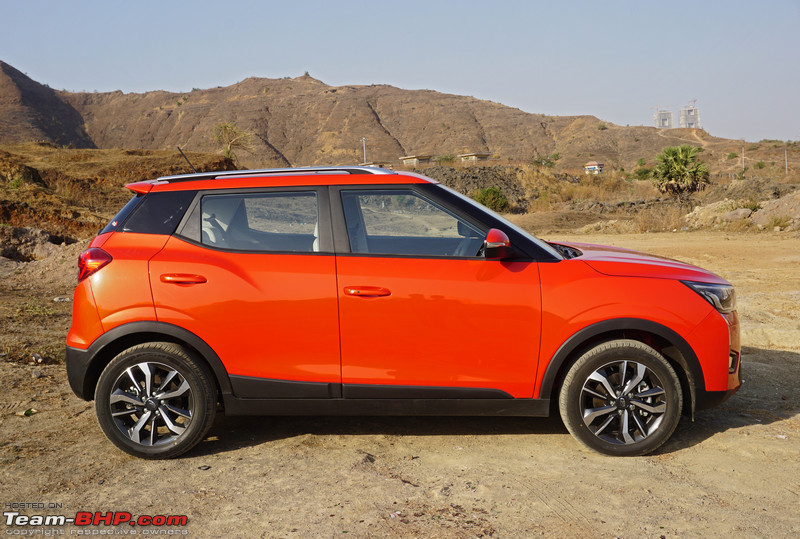 One of the best angles to view the XUV300 from. It has a wheelbase of 2,600 mm, which is the longest in the segment. Its 1,821 mm width makes it the widest car in the segment too:  While there are some prominent cuts and creases on the sides, they don't seem overdone and gel nicely with the overall design. Just see that prominent rear haunch! Ladies found this Sunburst Orange colour of our test car "sexy". We loved it too:  Headlamp clusters of the W8 & W8 (O) variants have black and chrome inserts. Low beam projectors are regular halogens. Follow-me-home and lead-me-to-vehicle functions have been provided. DRLs are integrated in the headlamp cluster and run on the top as well as the sides. They extend down onto the bumper, which is unique:  With all the lights in action:  DRLs are bright and prominent, even during the day: 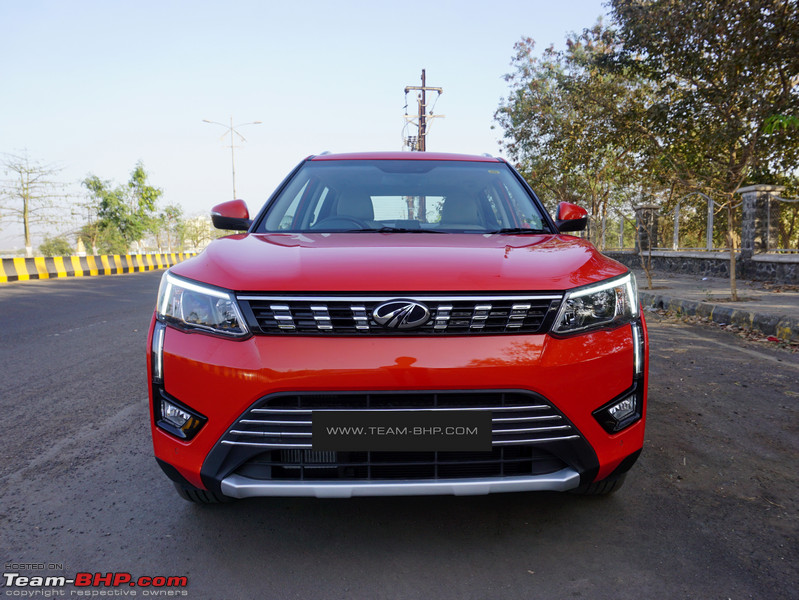 Piano black grille features a large Mahindra badge, a chrome strip on the top and multiple small chrome inserts as seen in the XUV500. The chrome strip on the top merges with the LED DRLs in the headlamp clusters. Overall, the grille is slim & chic:  Front bumper is dominated by the large air dam with four horizontal chrome slats and a silver skid plate. The DRLs appear to connect the headlamp clusters to the foglamps, which have piano black housings:  Small halogen foglamps provide adequate illumination. Cornering lamp function is not provided. Parking sensors are located below them, close to the corners of the bumper. When you are driving in the city and go too close to a car, the parking sensors will warn you. It’s probably a good thing considering the width of the car:  Front towing point is neatly integrated in the air dam:  Small, silver plastic skid plate adds to the SUV'ish look, but it is obviously not functional. There is a good deal of underbody protection - necessary since the unladen ground clearance of the car is 180 mm. Sufficient, yet the lowest in the segment:  Long bonnet features a wide and largely flat central dome, while the prominent creases on the side give it some muscle:  The XUV300 is equipped with automatic rain-sensing wipers. The sensor is located in the center of the windshield:  Old-school wiper blades. We were hoping the XUV300 got aero wiper blades like the Marazzo (link):  Windshield washers are hidden under the bonnet. Each unit shoots out water through three nozzles:  Big wipers have a good sweep:  Shut lines are tight & uniform - the best we have seen on a Mahindra car:  However, they get wider around the bonnet...  ...and tailgate:  Dual-tone body colour + black ORVMs with integrated turn-indicators. Notice the subtle chrome insert around the blinker. The ORVMs don't move the other way. They could get damaged if a biker side-swipes them. Surprising miss by Mahindra as almost all cars today offer India-friendly ORVMs:  W8 and W8 (Optional Pack) variants get this request sensor on both front door handles. Simply walk up to the car with the key on your person and touch the request sensor to lock / unlock. Keyhole is provided only on the driver's door:  Roof slopes down towards the rear. A, B & C-pillars are blacked out, giving a floating roof effect. Looking at the roof section reminds us of the Mini Cooper in some ways:  C-pillar is thick and has a shiny black panel which merges with the rear windshield. Notice the vertical crease on it:  Just look at the beefed up wheel arches!  Similarly, there's a prominent haunch that originates on the rear door and runs across the rear panel, merging into the tail-lamp. You can see this in the ORVM   Front tyres get aero flaps ahead of them:  Black plastic cladding runs along the wheel arches. W8 (Optional Pack) variant gets the FUNKY 17" black and silver diamond cut rims shod with 215/55 MRF Wanderer tyres. They fill up the wheel wells nicely. Like the Vitara Brezza, these get 5 lugnuts. W8 variant gets different 17" alloy wheels, while lower variants get 16" steel rims, with 205/65 section tyres:  Prominent crease runs low on the doors. Black cladding for that crossover look!  Cladding extends all the way down to the frame of the XUV300. Corners haven't been cut with this car:  Subtle protrusion on the cladding of the rear wheel arch acts as a splash guard:  Disc brakes are provided on all four wheels of the XUV300 - a segment first:  Like other sub-4 meter cars, the rear bumper doesn't protrude out and the rear looks chopped off (which it is actually). A rear impact will easily dent the tailgate:  W8 (Optional Pack) variant gets a very-welcome sunroof. The other two to offer a sunroof in this segment are the EcoSport & WR-V:  W8 (Optional Pack) variant gets dual-tone roof rails (cosmetic only), while W8 and W6 variants get black units. W4 base variant has none:  Stubby antenna sits at the rear of the roof. A shark-fin unit isn't available, even as an accessory:  Tailgate gets a neatly integrated spoiler, which houses an LED HMSL:  Windshield washer is neatly integrated in the spoiler:  Split tail-lamp clusters have an LED outline for the pilot cum stop lamp (all others are halogen):  With all the lights in action:  When the brakes are applied, the LED strip becomes brighter and the lights above the turn-indicator and reversing lamp glow. Love the attention-to-detail:  Number plate is housed in a large recessed area on the tailgate. Rear windshield is proportionately sized. We appreciate that a chrome strip has NOT been slapped on:  Only the W8 and W8 (O) variants get rear wash & wipe and defogger. Quite stupid from the safety POV:  Reversing camera is tucked away, above the number plate with the electromagnetic boot release next to it:  Yes to variant badging, no to engine badging (anywhere on the body):  Like the front bumper, the rear one is a dual-tone unit too. It houses two foglamps, four parking sensors and a large silver skid plate: 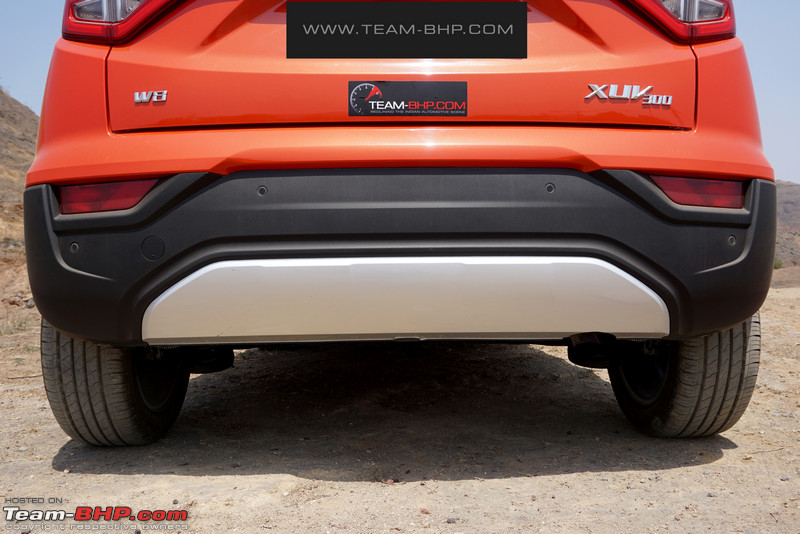 Rear towing-point cap has an arrow indicating where you should press to remove it:  Twist beam suspension with coil springs at the rear. Mahindra has said that a particular batch of dampers was defective. Our test car was one of the vehicles with these defective shock absorbers & it resulted in dangerous high speed behaviour. If you've bought an XUV300, I would strongly recommend that you call your dealer & check if your car is affected. Exhaust pipe peeps out from a cutout in the silver skid plate:  Shot at the Mumbai-Pune mega meet (link). XUV300 looks boxier and edgier than the more rounded and funky Ford EcoSport. We like the styling of both!  Tailgate-mounted spare gives the EcoSport a more SUVish look than the XUV300's hatchback-like rear:  Both are among the best lookers from this segment IMHO:  XUV300's body line is more conventional than the coupe-like Nexon. The Mahindra will appeal to most, while the funky Nexon will divide opinions:  Last edited by Aditya : 6th May 2019 at 17:49. Reason: Image alignment. |
| |  (62)
Thanks (62)
Thanks
|
| The following 62 BHPians Thank Aditya for this useful post: | abhinav.s, Added_flavor, AdityaDeane, adneeraj, aeroamit, akshay81, amit1agrawal, amit_purohit20, AutoIndian, benbsb29, BlackPearl, carrazy, Chaman K, ChiragM, Chrome6Boy, CrAzY dRiVeR, dailydriver, DevilzzzzOwn, Dr.AD, FrodoOfTheShire, ganeshb, GKMahajan, GTO, hdman, InControl, johannskaria, JoseVijay, lemedico, Leoshashi, Malabari, myavu, N33raj, PapaKiloSierra9, phoenixash, PraNeel, PrasunBannerjee, RaghuVis, RavenAvi, samabhi, sayakc, Scorpion 10, Sheel, shipnil, Simat, Simhi, sparky@home, spd_tkt, suhaas307, sukiwa, sunny29584, surjaonwheelz, theexperthand, Thermodynamics, The_Outsider!, timuseravan, TusharK, uday.ere, vaasu, Varun_HexaGuy, vb-saan, vijit.gangwar, VTec_KickedInYo |
| | #4 |
| Team-BHP Support  | Interior - Front 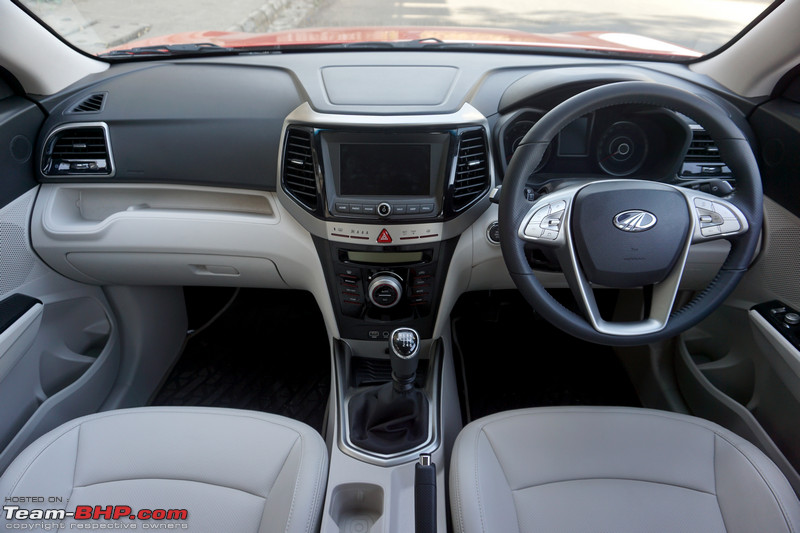 The front doors open and shut in a triple-stage action. As mentioned earlier, they have a fair amount of weight to them. There is a good “thud” when you shut them. The doors don't close easily and need to be pushed hard at times. They open wide enough and the running board is not excessively wide. The floor of the car is at a comfortable height, while the roof is on the higher side. Thus, it's very easy to step in and out. Once inside, the XUV300 offers sufficient legroom & headroom at the front. The front windshield is large, but the roofline slopes downwards and I found the rear windshield + windows to be on the smaller side. Still, there is enough light entering the cabin to keep occupants from feeling claustrophobic. The use of beige on the dashboard, doorpads, seats, pillars and roof helps matters. Except for the long gearshift, this feels more like a mini-Creta than a Mahindra! Reminds one of a Hyundai in many ways. Even if you look at the steering design, it’s very similar to what we have seen in some Hyundais. The XUV300 feels like a top quality package the minute you get in. As expected for this segment, the plastics on the dashboard are all hard, yet their quality is better than the main rivals in the segment. It's even superior to the more expensive XUV500! Almost every part is well-finished and there are barely any rough edges. The seats get leatherette (artificial leather) upholstery and there is some leather applied on the doorpads as well. The dashboard’s styling is functional, and there is no "wow" factor. It has a beige & black theme with silver inserts, while piano black has been used on the center fascia (climate control panel) and air-con vents. While the lower part of the dashboard is beige, the carpets and floor mats are thankfully black. This is cleverly thought out as they will do well to conceal any signs of soiling. Ergonomically, the cabin is well laid out and all controls are easy to find and reach. The feel, quality and finish of most of the buttons / switches is good:  Windscreen is huge and offers a good view of the road ahead. The seating position is a little high up, but it's more like a tall hatchback than an SUV. Owners will appreciate that they can view the bonnet while driving. Not only the bonnet...you can also see the contours on its sides!  Smart leather-wrapped steering wheel has a perforated pattern, silver inserts and thumb contours. Design is very Hyundai-like. It is sufficiently thick and feels great to hold, with adequate grip on offer. The steering-mounted controls have large buttons, which makes their operation easy. The hornpad isn't easy to reach for those with shorter thumbs, but is easy to press: 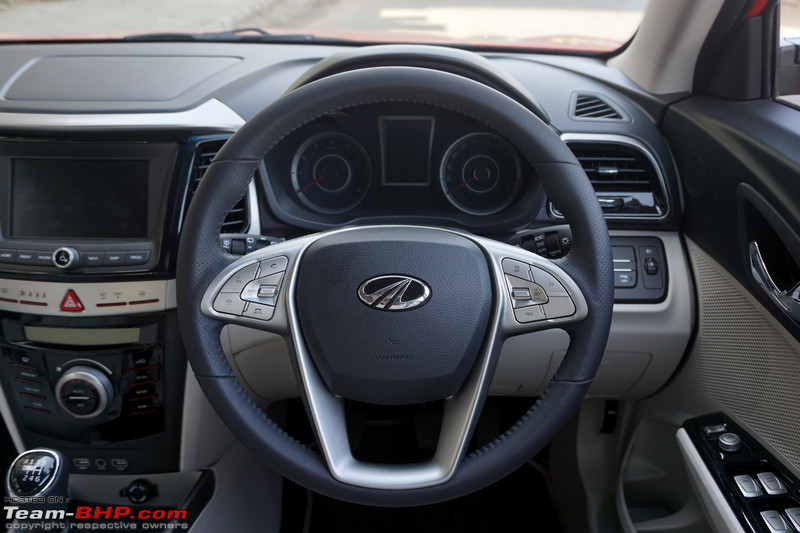 Buttons for the infotainment system and telephony are placed on the left spoke. Mute function (very useful) has a dedicated button which has to be long pressed. The track change and mode buttons are terrible to use. Several times, one ends up changing the source instead of the track (we frequently went from Bluetooth to radio). It doesn’t have a tactile feel. Buttons for operating the cruise control and voice commands are placed on the right spoke:  Zooming in to show you the very-consistent stitching pattern on the steering:  While the finishing is very good at most places, the top of the hornpad has a rough, unfinished edge:  Steering can be adjusted for height only, not reach - even in the top spec! This is a major omission as a reach-adjustable steering greatly contributes to the 'perfect' driving position. Any car with premium aspirations MUST have this. It must be noted that the Ford EcoSport, which was the car that started the sub-4 meter SUV segment, comes with telescopic adjustment:  Engine start/stop button has a chrome ring around it. If you press the engine start/stop button without pressing the clutch, a red light glows ("ignition on" mode). When you press the clutch, a green light comes on. Press the button to start the engine and the light goes off:  Simple instrument cluster is easy to read. Tachometer on the left & speedometer on the right (just the way we prefer it) with a 3.5" TFT MID in between, with the digital fuel and temperature gauges. Meters have red outlines, and red parallel rings running on the inside too. We like how the redline is marked differently. While the tachometer of the petrol is marked till 8,000 rpm... 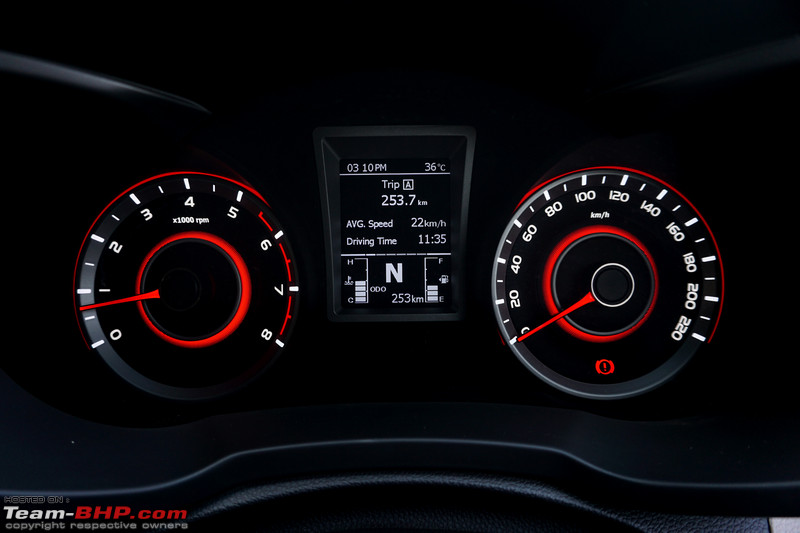 ...the revv counter of the diesel is marked till 6,000 rpm:  The MID shows an odometer, dual trip meters, time, outside temperature, average and instant fuel consumption, a distance-to-empty counter and digital speedometer. The trip meters show their own average speed and driving time (individually). The selected gear is displayed as well (pointless IMHO). When the MID is in the digital speedometer mode, long pressing the "set" button (weirdly placed on the center fascia) will turn the illumination of the instrument cluster including the needles, rings and numerals on / off. So basically, you can drive with only the digital speedometer & MID showing:  The MID throws up a number of warnings. Upon switching the car on - if the front wheels are in a turned position - the system warns you accordingly (see the Hyundai influence?). There is a warning for an open sunroof if the engine is switched off, service reminder and seatbelt reminder for both the front seat occupants. It also displays the specific door that is open. We appreciate that a bonnet-open warning has been included (this is rarely ever seen in cars). There is a parking sensor display for the front as well as the rear:  If the bonnet is left open, the MID shows the car's bonnet flashing. The hazard lamps start flashing as well. Excellent attention-to-detail! 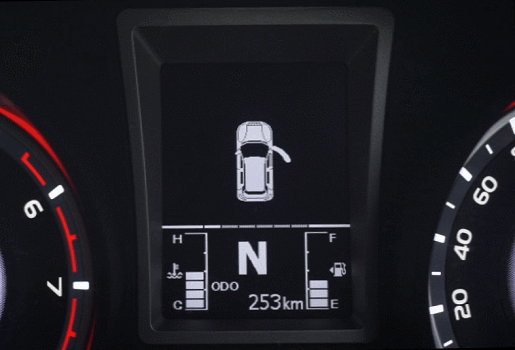 MID settings can only be changed when the car is stationary. The colour of the inner rings of the meters can be changed (separately for day / night if you find the red too bright), along with the brightness levels of the cluster. The overspeed flash is a visual warning wherein, the inner rings of the speedometer start flashing when the car touches 160 km/h. You can disable the welcome sound too:  You can choose between red...  ...yellow (yuck!)...  ...sky blue...  ...dark blue...  ...and white (the only one we'll consider):  The illumination of the inner ring can be turned off as well (our top choice & incidentally, all the colours of the Team-BHP logo):  Very busy stalks. Wiper and light stalks give positive feedback and are great to use. Foglamp switch is integrated on the light stalk itself. Auto headlamps and auto rain-sensing wipers work like a charm. A lane change indicator is present. See the second 'auto' setting on the left (silver button)? That's for one-touch washing & wiping of the windscreen! Press it once and water will be sprayed for 2 seconds, then the windshield will be wiped 4 times. After that again, the washer fluid will be sprayed for 1.5 seconds & the wipers engage for 3 seconds. Mist feature is provided as well. Rear wiper has two speed settings. The silver button on the light stalk is a dummy unit:  Side air-conditioner vent has a piano black surround with a silver border, and a chrome tip on the air flow direction controller. The air flow volume can be regulated as well. In the "OFF" position, absolutely NO air flows out of the vent (again shows attention to quality):  Buttons to disable the traction control system (don't ever do this in India), idling start-stop system (recommended) and front parking sensors are here. Note that switching the parking sensors off will only stop the warning beeps from the front parking sensors. The visual warnings continue to be displayed. The three blanks give an impression that something is missing in an otherwise loaded car:  Fusebox is located low on the dashboard:  White OBD port is located at its base:  J-shaped bonnet release lever is easy to hold. It is sturdy & well-finished:  Fuel flap release lever is located on the floor and sticks out of the carpet. Floor mat should have featured a cut-out (as seen in other cars) for easy removal:  Like the dashboard, the doorpads get a black + beige colour theme with a piano black insert. The beige portion is at the middle and lower down. It's sure to get soiled with time. The doorpads are well finished with no sharp edges anywhere. Notice how the speaker is placed in the upper half:  W8 and W8 (O) variants get chrome door handles. While the handle itself is sturdy, the lock/unlock lever feels flimsy. Lesser variants get black door handles. A small usability add-on – the kind of things that make a big difference on a day-to-day basis – if you want to open the driver’s door, you just have to pull on the handle (no need to unlock via the lever first):  While all the plastics are hard, there is a soft, leather pad where the driver's elbow will rest:  Good-looking silver buttons for the power windows and ORVMs. They're housed in a piano black panel. Action of the power window buttons is clicky & flimsy. They don’t feel robust either. Only the driver's window gets one-touch up / down & anti-pinch. The windows also have an 'extended operation' feature wherein, you can operate them for a while even after the car's engine has been switched off. Useful to catch any window that's been left open. ORVMs get the auto-folding function on lock / unlock. Switches for the windows are illuminated in orange, which seems so yesterday!  Exposed screw on the doorpad looks ugly and out of place in an otherwise good interior. Should have been covered up with a cap:  Door pockets are deep, but thin. They can hold 2 bottles and some knick-knacks:  Both front doors get red warning lights:  Door sills aren't too wide, which means lesser effort to move your feet in & out of the car. Black scuff plates provided:  Front seats are draped in off-white leatherette upholstery...how incredibly silly for India! These will get dirty within a week of ownership - what was Mahindra thinking? Because of the airbags, owners can't even put seat covers over these. Lower variants get more practical black seats. Seats are wide enough to suit even larger drivers. While the under-thigh and shoulder support offered is enough, lower back support is ordinary. Lumbar adjustment is missing and those with a delicate back are likely to complain. The seats have something that Mahindra calls "dual stiffness foam" in them, but I felt they could have been firmer, which would have made them more suitable for longer drives. The headrests are adjustable, but are on the firmer side. A convenient center armrest has been provided as well:  Sturdy levers to recline the seat and adjust its height:  Solid metal lever for fore & aft movement:  Fore & aft travel is good enough to allow even drivers with a laidback driving position to be comfortable:  Healthy range for the seat height adjustment. Short or tall, no one will complain. Even the headroom is enough - with the driver's seat at its highest position, I @ 5'10" had about an inch of headroom to spare:  The leatherette upholstery is well stitched and the quality of material is good. Notice the perforated design pattern (it's fake, of course). Just wish a more sensible colour was chosen:  Front seatbelts are height-adjustable:  Front seatbelts get pretensioners. Like the Marazzo, the pretensioners are exposed units:  One of the rare cars in which the brake pedal is almost at the same height as the accelerator pedal. Usually, the difference is more. Additionally, the accelerator is too close to the brake pedal. There will be some times when you intend to press only the brake pedal, but you’ll press the brake + accelerator at the same time!!! This is a design failure for those with a large shoe size. No dead pedal provided:  ORVMs are sufficiently wide, but could have been taller towards the outer ends. W8 (O) gets heated ORVMs which can be used to get rid of mist. An incredibly sweet touch – from the ORVMs, you can see the muscular haunches of the rear wheel arches (like in sports cars). The only other car I remember seeing this is in is the new Swift:  IRVM is wide enough to cover the entire rear windshield. Thick C-pillars restrict visibility though:  IRVM gets the auto-dimming function. While it is "ON" by default, it can be switched off by pressing a button. When it is active, a green light glows:  Sensor for the 'automatic headlamps' is located behind the IRVM (basically, facing the road ahead):  While reversing, the rearward view is just average. The rear windshield is short in height and the C-pillars are thick. Better to rely on the reversing camera and parking sensors:  Center fascia gets a combination of shiny piano black and silver inserts around the ICE and air-con vents. Piano black has been used on the climate control panel as well:  A look at the dash area, on top of the center console. Just a design, although one gets the impression that a storage compartment has been left out:  7" touchscreen head-unit sits at the top of the center fascia. Its functions are covered in a separate post. A silver casing runs around the entire unit:  Buttons to operate the rear defogger, hazard lights, MID (weird placement for MID here) and steering modes are located below the ICE. Seatbelt reminder lamps for ALL passengers (including 5th) are placed here as well:  Dual-zone climate control system, a first in segment feature, has 3 memory settings (three different sets of temperatures can be memorised)!! The blower has 8 levels of adjustment. It starts getting loud on levels 4 and 5, while on levels 6, 7 & 8, it is annoyingly loud. Best to keep it at level 3. The lowest temperature that the system goes to is 18 degrees centigrade before hitting LO, while the highest is 32 degrees before hitting HI. Air-conditioning is not as chilling as we have seen in some other cars. It is strictly average on a blazing summer day. At the front, it is just about adequate; at the rear, things can get warm as there are no rear vents & the front unit is so average on a hot day. Our petrol test car's climate control system had a bug. Whenever the engine was revved hard, the cooling would stop. However, this problem disappeared after restarting the car (we didn't face this problem in the diesel). Another complaint we have is that the display has a dated look and the buttons are thin, making them difficult to operate:  Aux-in and a pair of illuminated USB ports are located below the climate control system. While the USB port on the left is for charging devices, the one on the right allows you to connect your smartphone for Android Auto / Apple CarPlay:  12V power socket is located at the base of the center fascia, along with a storage space for your smartphone. It has a rubber lining on the surface for protection:  Bird's eye view of the center console. Armrest is not adjustable, but it is placed at a comfortable height and has a soft leather cladding. Handbrake is heavy to operate:  Two cupholders are located to the left of the handbrake. Each gets 3 grips to hold the cup in place. Good attention to detail: 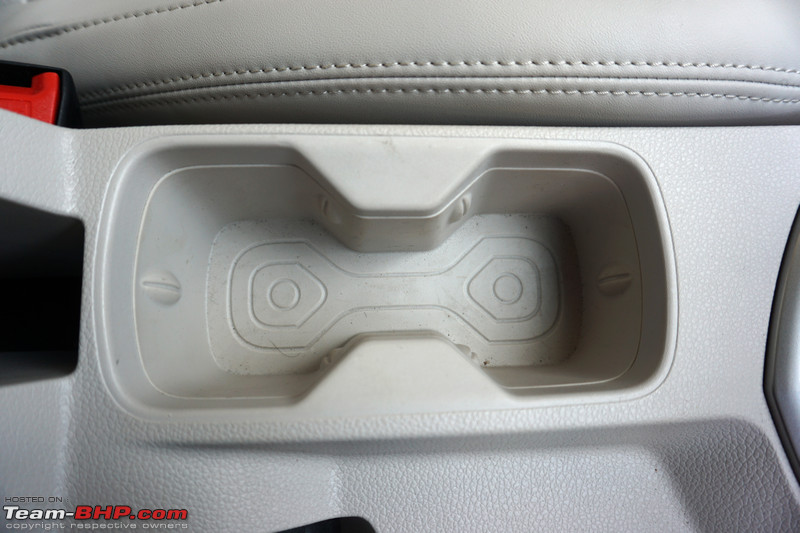 Center armrest has a deep storage compartment underneath. Its strange shape can reduce its versatility. Floor has a soft lining:  Cut-outs in the front wall and lid allow one to store a tablet in the storage compartment:  Along with the dual-tone colour theme, strong creases keep things from getting boring on the passenger’s side of the dashboard:  Long and fairly deep storage space above the glovebox. One can keep odd items here. Has a partition (left of the smartphone) to keep things from falling:  Glovebox is medium-sized. Light is active only at night (when the pilot lamps are on). Cooling vent missing (mentioning since the car is otherwise so loaded):  Glovebox lid gets a compartment to store the owner's manual of the car: 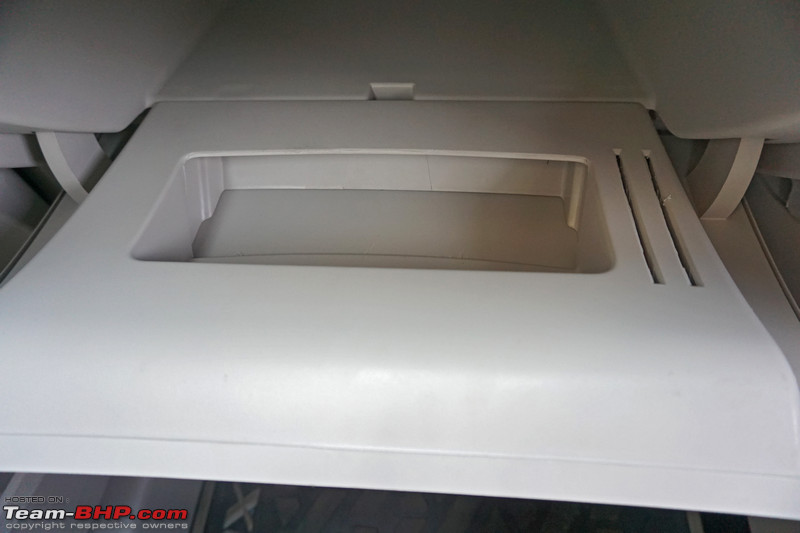 Roof bezel consists of map lights, a sunglass holder and sunroof controls. After locking the car, all cabin lights go out with a theatre-dimming effect:  Sunglass holder has a soft opening action and a protective lining on the inside to prevent your sunglasses from getting scratched: 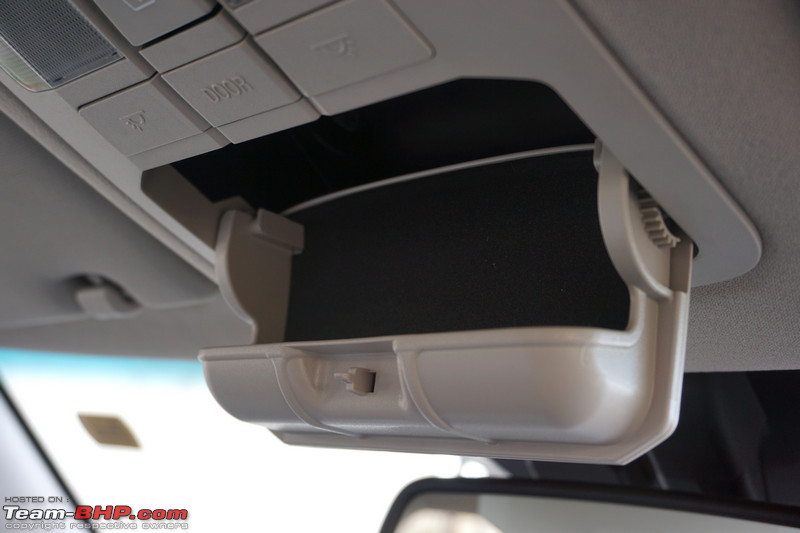 Spring-loaded grab handle above the passenger door. There's none on the driver's side:  Bluetooth mic is located above the driver's sunvisor. It should have been integrated in the roof lamp console for a cleaner look IMHO:  Sunvisors are well built. Both units get a slot to hold tickets...  ...and illuminated vanity mirrors with a lid. No cost cutting in this car:  Dual airbags are standard on all variants of the XUV300. W8 (O) trim is the only SUV in the C2 segment that gets 7 airbags in total!!! These include…  ...a driver's knee airbag...  …side airbags (no seat covers here please)…  …and curtain airbags:  Airbag marking on the B-pillar:  Sunroof cover is manually-operated:  A view out of the sunroof. It has an anti-pinch feature:  You can pop it up for ventilation by pushing the button upwards:  With the sunroof open, a lot of light comes into the cabin. This is the max it opens to:  Things are neat & tidy even in places where most people won’t look. No loose wires or bits dangling anywhere. Notice the S201 marking on the EPS unit. The XUV300 project was codenamed S201:  Foam insulation on the underside of the dashboard in the passenger footwell aids in keeping engine noise out. Wow! The cabin is very well insulated indeed:  Last edited by GTO : 15th April 2019 at 09:58. |
| |  (51)
Thanks (51)
Thanks
|
| The following 51 BHPians Thank Aditya for this useful post: | AdityaDeane, akshay81, amit_purohit20, AutoIndian, carrazy, Chaman K, ChiragM, Chrome6Boy, dailydriver, DevilzzzzOwn, FrodoOfTheShire, ganeshb, GKMahajan, GTO, hdman, InControl, johannskaria, JoseVijay, lemedico, Leoshashi, LoneRidder, N33raj, nmenon, Nohonking, PapaKiloSierra9, phoenixash, Ponbaarathi, PraNeel, RaghuVis, RavenAvi, Scorpion 10, Sheel, shipnil, shobhit.shri, Simat, Simhi, suhaas307, sukiwa, Sumer, sunny29584, swiftnfurious, theexperthand, Thermodynamics, The_Outsider!, timuseravan, uday.ere, vaasu, vb-saan, vijit.gangwar, Vik0728, VR4 |
| | #5 |
| Team-BHP Support  | Interior - Rear Like the front, the rear doors of the XUV300 also open and close in a triple-stage action. They swing out sufficiently wide, the roof of the car is pretty high and the floor isn't too high off the ground. This makes ingress & egress convenient for most people (including the elderly). The rear seat is placed at a comfortable height as well:  Adequate space between the B-pillar and the bench makes it easier to step in & out. Door sill isn't excessively wide, which means occupants don't have to carry their feet over too much when entering or exiting the car. Unlike the front, the rear door sills do not get scuff plates:  Like the front doorpads, the ones at the rear have a black & beige theme with a piano black insert. The rear speakers are similarly mounted in the upper half, while the armrest area gets a soft faux leather surface:  Door pockets are just as narrow as the front ones and can hold a 1L bottle + other slim items:  Unlike many of its competitors, the rear seat is wide enough to accommodate 3 average-sized adults. Larger adults are likely to find the space tight though. While the seatbase is largely flat, the seatbacks have some contours to hold you in place:  Legroom is healthy and two 6-footers can sit one behind the other in reasonable comfort:  Rear bench gets 3 headrests - all are on the firmer side. All 3 occupants get 3-point seatbelts as well. Center passenger sits a little higher up due to the slightly elevated seatbase; he also sits a little more in the front because of the center armrest. Yet, the width of the car makes it easier to sit three abreast:  Seatbelt buckles are housed in dedicated cut-outs. Additionally, they get an elastic strap to keep them down. It's the little things, really!  ISOFIX child seat anchors have been provided on both sides:  A look at the maximum and minimum legroom available:  With the front seat in my driving position, I have about 2.5" of knee room to spare. With the front seat moved all the way back, I have barely an inch of knee room. The seatbacks of the front seats are hard which isn't cool at all!! In almost all cars, the seatback area is soft, thus it doesn't hurt you. What helps matters a little bit is they are scooped out where the knees are placed (but it's still not an ideal situation):  The seatback doesn't recline, yet the angle is comfortable. Those who are 5'9" & taller will find the seat to be a little on the lower side (as a result, lesser under-thigh support too). All headrests are adjustable & useful:  Unlike the stupid hard seatback area, the surface at the base of the seats is soft, so it won't hurt your legs. There is enough room under the front seats to tuck your feet in:  Roofliner is scooped where the rear passengers' heads would be. Headroom was adequate (not excessive) for me @ 5'10":  The center armrest is positioned at a comfortable height:  It is wide & soft, and comes with two cupholders:  Overall glass area is adequate, but shorter passengers will feel some restriction due to the way the window line slopes upward. Still, there is enough light coming in and the cabin doesn't feel claustrophobic at all: 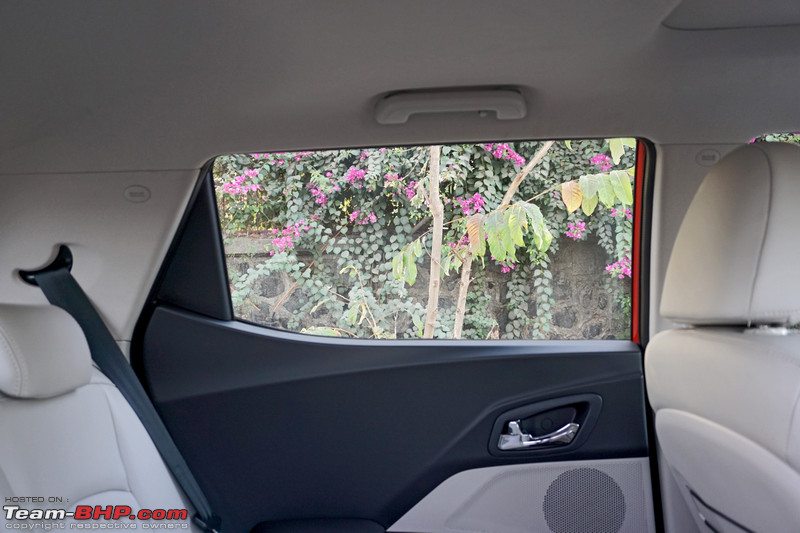 Window rolls all the way in:  No seatback pockets. Instead, what you get are bungee straps for storage. They look cool, but are absolutely useless for storage. @ Mahindra: why fix something that isn't broken?  Apart from seatback pockets, Mahindra has also missed out on providing air-con vents and a 12V charging point for rear passengers. Air vents at the back help in maintaining a more consistent temperature across the cabin. On a hot day, things do get warm at the back. The driver will have to put the front air-con on full blast:  Spring-loaded grab handles. Both rear units get useful coat / bag hooks:  Seatbelts can be parked in these slots (when folding the rear seat down):  Whitish-grey roofliner dips down where the sunroof is located. 2nd cabin lamp is placed behind the sunroof, hence serving both seat rows:  Cabin lamp has one button with two positions - ON (pressed) or door (not pressed). There is no "OFF" position & we agree with this (why would anyone want to disable the cabin lamp?):  Short floor hump isn't much of a bother. Interestingly, the XUV300 brochure claims that the car has a flat floor (which is clearly not the case):  257-liter boot is the smallest in the segment. It can accommodate small to medium-sized bags only. This will be a deal-breaker for many owners considering the XUV300 as their sole car. The Tivoli has a larger boot, but as you know, Mahindra chopped off the rear to bring the length under 4 meters:  While slots for a parcel tray have been provided, Mahindra isn't giving you one. Period. Reason? A parcel tray will make the boot look even smaller in the showroom. It's a marketing trick:  Area on the tailgate - where the hook to hang the parcel tray would be - is blanked out by plastic. Gives the impression that something is missing:  Boot light is located on the right:  The boot floor is adjustable for 2 levels:  There is a visible difference between the 2 levels of adjustment. Here is how the boot looks with the floor at the higher level...  ...and at the lower level:  For increasing cargo space, the rear seats can be folded down. Pull this knob up to unlock the seatback; we feel it's rather big & ugly looking:  Rear seat has a split, but instead of the usual 60:40 split, it's a 40:60! Basically, the split is oriented for left-hand-drive. The seatbase is fixed and cannot be tumbled forward like in the EcoSport (click to see):  Folding the seat down gives you cargo capacity of 625 liters:  Move the boot floor to its upper level if you want an area that's closer to flat (but still not flat):  Top tether for the child seat (there's one on each side of the rear seat): 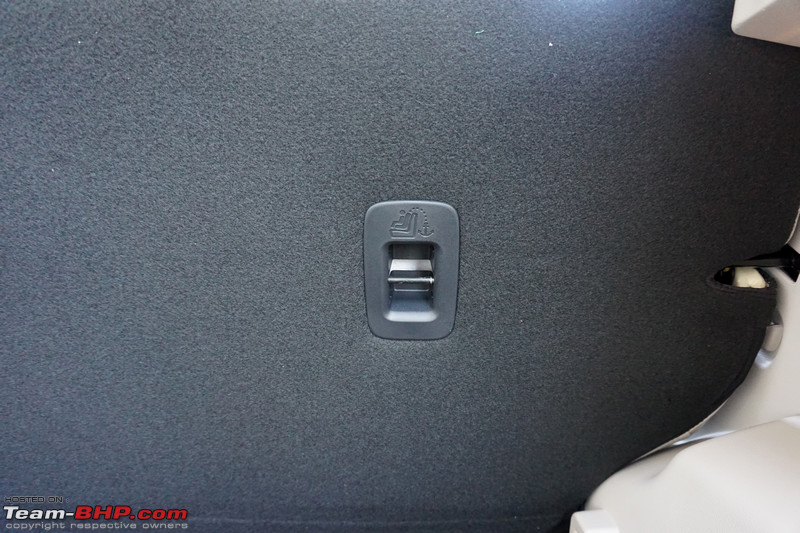 Loading lip is high. One will have to make the additional effort of lifting bags over it and placing them inside the boot:  Tailgate gets full plastic cladding on the inside. No ugly bits sticking out anywhere:  Remove this cap at the base of the tailgate...  ...to access the tailgate emergency opener. Move this lever to the left to open the tailgate. It's the first time we're seeing this feature in this segment:  Both sides of the tailgate get plastic covers, which can be pulled out... 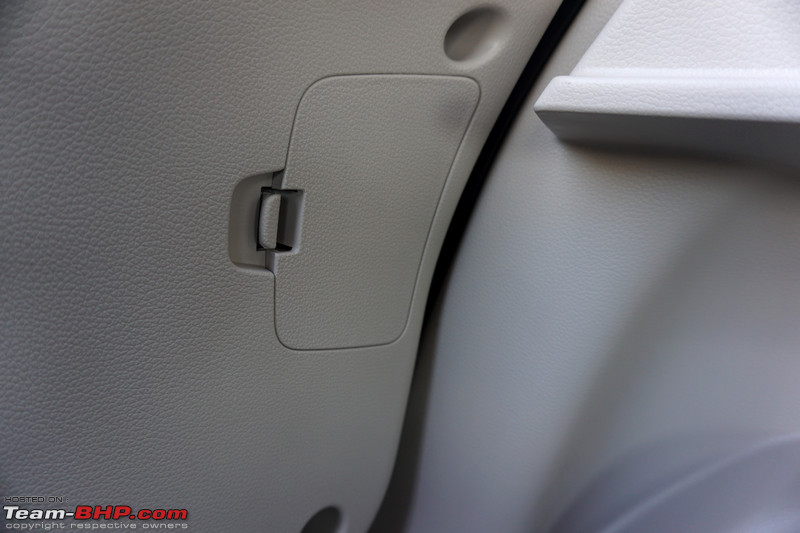 ...to access the bulbs of the part of the tail-lamps housed on the tailgate:  Lift the boot floor up with this strap to gain access to the tool kit & spare wheel:  Boot floor has a segmented design and has to be lifted out in a stepped manner:  Tools are neatly arranged in a Styrofoam casing kept within the spare wheel:  Nope, the spare isn't an alloy wheel. You get a steel rim instead (full-size):  Last edited by GTO : 15th April 2019 at 09:56. |
| |  (42)
Thanks (42)
Thanks
|
| The following 42 BHPians Thank Aditya for this useful post: | akshay81, amit1agrawal, amit_purohit20, carrazy, ChiragM, Chrome6Boy, DevilzzzzOwn, DrANTO, Enobarbus, FrodoOfTheShire, GKMahajan, GTO, hdman, InControl, johannskaria, JoseVijay, lemedico, N33raj, nmenon, Nohonking, PapaKiloSierra9, phoenixash, Ponbaarathi, RaghuVis, RavenAvi, Scorpion 10, Sheel, Simat, Simhi, sukiwa, sunny29584, swiftnfurious, theexperthand, The_Outsider!, timuseravan, TusharK, uday.ere, vaasu, Varun_HexaGuy, vb-saan, vijit.gangwar, WindmillsFly |
| | #6 |
| Team-BHP Support  | In-Car Entertainment Except for the base, all variants get a 7.0-inch touchscreen system with Bluetooth, USB & Aux, along with a video and image viewer, navigation and voice commands. Android Auto and Apple CarPlay have been integrated as well. The ICE also features Ecosense (which shows you how economically you have been driving), the Mahindra Blue Sense App and Emergency Calling function. The touchscreen further serves as a display for the reversing camera (top two variants only). The touchscreen has no lag and the screen resolution + clarity are good. Visibility is satisfactory even under direct sunlight. Physical buttons for the most used functions (including a home button) have been provided for convenience. "DISP" button switches the screen off if it bothers you at night:  In the higher variants, music is played via 6 speakers, including one on each of the 4 doors...  ...and a tweeter on each of the front doors:  This is the home screen. The time and connected smartphone status are displayed at the bottom. What is very annoying is that the ICE restarts only in radio mode!! We used the system via Bluetooth and yet, every time we restarted the car, it went to the radio. The ICE should remember your last chosen source. Equally irritating = the system always starts at zero volume, which is a pain. It should ideally start at the last chosen volume level or somewhere in the middle:  A variety of settings can be altered to suit the owner's preferences:  You get the usual sound adjustments. Sound quality is decent as long as you don’t turn the bass up. If you go heavier on the bass, the speakers immediately start crackling. Except for this issue with bass, sound quality is fair:  Set up the equaliser manually or choose from a range of presets:  You can turn off the welcome sound...  ...adjust the sensitivity of the speed dependent volume control...  ...and adjust the individual volume levels of each function:  You can adjust the brightness of this display...  ...choose what it shows when the power is off... 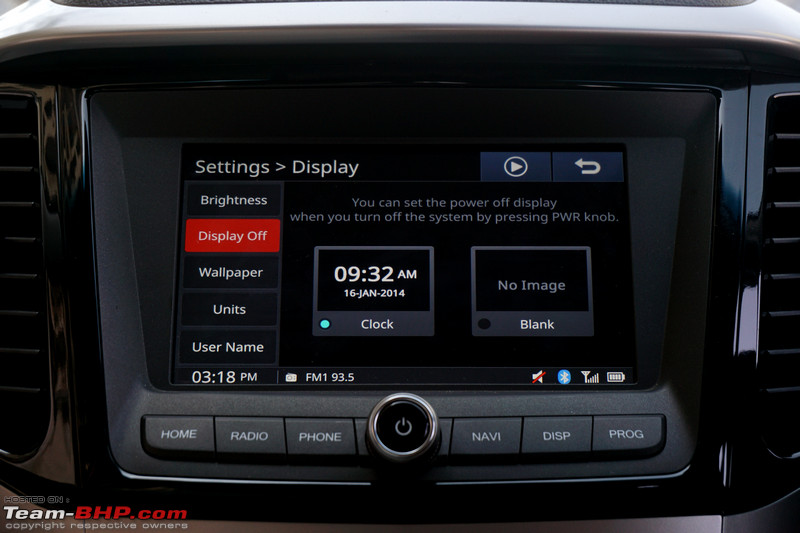 ...or set a wallpaper:  You can save the settings to a user profile (like in MS Windows). Might be useful if you're sharing the car:  Within Ecosense, you can enable / disable vehicle tracking...  ...and sync the system with the Mahindra Blue Sense App on your smartphone:  Strange to see an Indian company not supporting Hindi, when a Korean company (Hyundai) does:  The "program" button is basically a quick access one. Can be assigned to one of four functions:  In the Car Info section, you get data about the average fuel consumption and distance to empty:  A handy TPMS displays the air pressure & temperature of each tyre (including the spare):  One can go to the reversing camera view or switch the voice & text guidance on / off:  Alerts are displayed (along with sound warnings) for an open door, low fuel / oil, handbrake engaged, seatbelt unbuckled etc:  Service info:  You can turn the DRLs on / off. Better to keep them on. Not only do they look good, the DRLs also add to the safety (by increasing your visibility to others):  Ecosense provides average and instant scores for your driving based on various parameters such as speed, gear selection, acceleration & idling time. It also takes into consideration traffic conditions and the gradient of the road. The score starts from 100 when you start driving. At the end of the trip, the higher the score, the more economically you have driven. Not for guys like us who have a heavy right foot. If you so wish, you can share your score on social media (the Facebook, WhatsApp & Twitter icons): 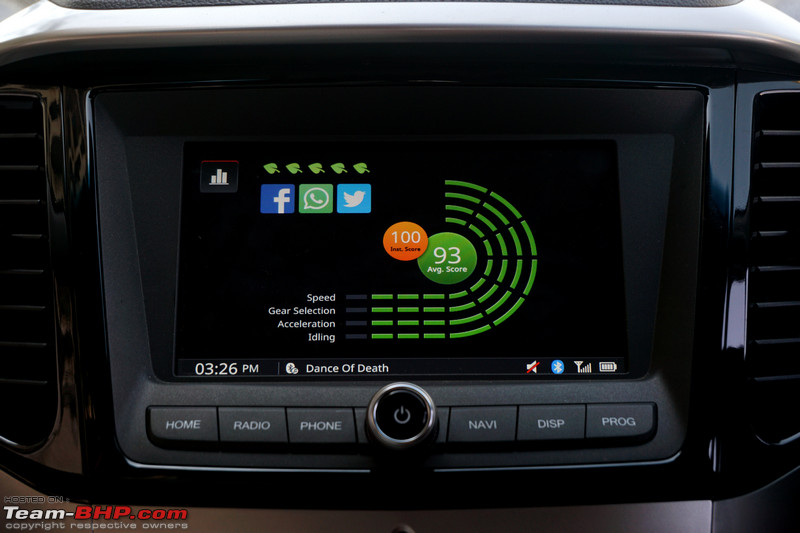 Trip history is stored (before you ask, yep, it can be deleted):  The score & stats for each individual trip can be viewed. Interesting to see how many times the average driver presses the clutch & brake per km of driving:  Chart showing you data for each trip. As an example, here's one for the average speed:  Inbuilt navigation with maps provided by MapMyIndia. Navigation accuracy is impressive and alerts for the speed limit are provided:  The XUV300 gets Android Auto in the W8 variants:  Navigation via Google Maps is obviously superb. Google also gives you real-time traffic updates:  Apple CarPlay has been provided for the iOS fans: 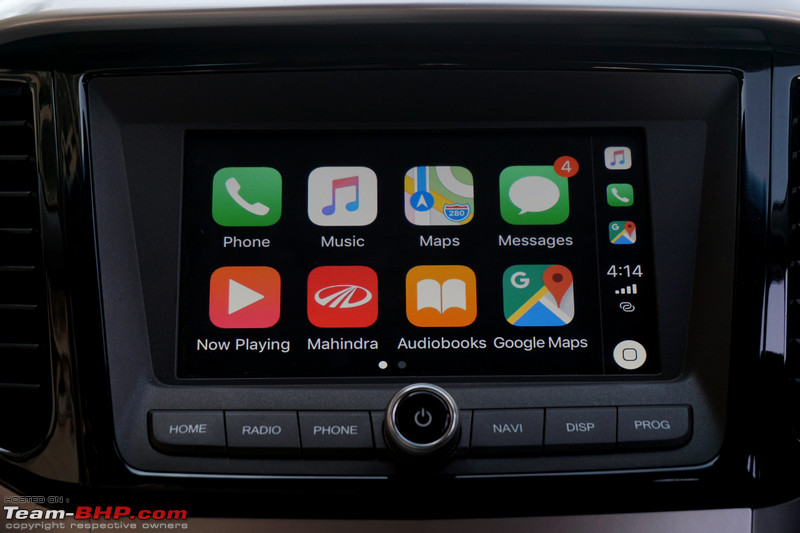 WhatsApp messages can be read out via Apple CarPlay & Android Auto:  Touchscreen doubles up as a display for the reversing camera. Resolution is fair and you get dynamic grid lines...  ...as well as angled parking + parallel parking assist:  You can zoom in when maneuvering into tight spots (Team-BHP.com is from the number plate  ): ): In the dark, the display quality is awful. We are disappointed that Mahindra has skimped here - there are cheaper cars with a superior camera:  The ICE can be synced with Mahindra's BlueSense app on your smartphone. Through the app, you can control the audio system and climate control. The app also gives you lots of info including status of the auto lights & wipers, parking lights, an e-manual and owner's manual etc. "Cluster info" tells you what all the warning lights in the instrument cluster stand for:  You can use the app to locate your car and find fuel stations near you (both through Google Maps), share your location, set your favourite places and make emergency calls (red SOS icon on the top right):  Set reminders, view fuel statistics, store documents and view the TPMS. It also tells you if your car requires a service:  Statistics provided by Ecosense can be viewed here:  The app has smartwatch compatibility. If you have a smartwatch paired with your smartphone, you can view and operate the infotainment system etc:  Among the functions available, you can control the audio / climate control and view the fuel stats:  Last edited by Aditya : 15th April 2019 at 20:37. |
| |  (34)
Thanks (34)
Thanks
|
| The following 34 BHPians Thank Aditya for this useful post: | akshay81, black.beauty, carrazy, ChiragM, Chrome6Boy, DevilzzzzOwn, FrodoOfTheShire, GKMahajan, GTO, hiren.mistry, InControl, johannskaria, JoseVijay, lemedico, myavu, N33raj, Nohonking, PapaKiloSierra9, phoenixash, Ponbaarathi, Prakritij, PrasunBannerjee, RavenAvi, Sheel, Simat, suhaas307, swiftnfurious, The_Outsider!, TusharK, uday.ere, vaasu, Varun_HexaGuy, vb-saan, vijit.gangwar |
| | #7 |
| Team-BHP Support  | Driving the 1.2L Petrol MT 1.2L, 3-cylinder petrol engine has a turbocharger; puts out 110 BHP & 200 Nm:  The XUV300 petrol is powered by Mahindra’s in-house developed 1,197cc, 3-cylinder turbocharged engine mated to a 6-speed manual gearbox. This is essentially a reworked & turbocharged version of the 1.2L unit found in the KUV100. It features variable valve timing and produces a healthy 110 BHP (@ 5,000 rpm) and 200 Nm (2,000 - 3,500 rpm). While the power figure puts it behind the EcoSport’s segment-leading 121 BHP (1.5L) & 123 BHP (1.0L EcoBoost), the torque rating puts it comfortably ahead of all its direct rivals. In two words, the petrol engine is "damn good". With a hefty kerb weight of 1,296 kg, the XUV300 is heavier than the EcoSport by 15 kg, making it the heaviest monocoque sub-4 meter SUV in India. It has a power-to-weight ratio of 85 BHP / ton and torque-to-weight ratio of 154 Nm / ton. While the former puts the XUV300 behind the EcoSport and Nexon, the latter is comfortably higher than all its rivals. To start the engine, you need to press the clutch and then hit the engine start button. While the clutch pedal is light, we found its travel range to be on the longer side for a monocoque crossover. Despite it being a 3-cylinder, very few vibrations come into the cabin. At idling, you can barely hear the engine and there are no vibrations felt anywhere. The refinement is certainly impressive! Not many will be able to tell that it's a 3-cylinder engine, whether at idle or on the move. Throttle response is acceptable & the XUV300 moves off from a standstill in a clean manner. Despite the turbocharger, the low-end performance is good. The car can pull from even <1,000 rpm fairly easily. It managed to clear a speedbreaker in second gear without a problem. You won't need to shift down too often. It is only when a gap to the vehicle in front needs to be closed quickly that one needs to drop a gear or two. The XUV300 does not fly off the line from the word go, but the engine starts coming into its stride above ~1,700 rpm. Around town, it can cruise at 45 km/h in 3rd gear with the engine spinning at 1,700 rpm. What is not good is that the power delivery at low revvs isn't linear, but spiky. Owners will need a little time getting used to this spiky nature of the engine. The minute the needle approaches 2,000 rpm, the thing suddenly starts surging ahead. One has to go easy if there are passengers onboard. The constant surge while driving can easily get to them. In the interest of user-friendliness, Mahindra should have given it a more linear power delivery (keeping the mass market in mind). The average Joe won't be able to drive the car in a very smooth manner. Some enthusiasts though, will enjoy it. On the open road, you'll enjoy the punch of the turbocharged motor. As mentioned earlier, the engine comes into its stride after 1,700 rpm and there is a strong surge post 2,000 rpm. Want to overtake? Just drop a gear and fly past the slow moving car. The XUV300 can make fast progress on the open road if you have a heavy right foot. What is also nice is that the motor actually sounds nice when revved hard. Enthusiasts will like it. Downside? The engine revvs till "just" 5,900 rpm which is on the lower side for a petrol. The fuel supply cuts off abruptly at this point. This rev limit can catch you out in the middle of an overtaking maneuver! Also, beyond 5,000 rpm, it doesn’t have much performance to offer. So, while the mid-range is impressive, the top-end is poor. The overall driveability is good and you won't find the need to downshift often, but there is some lag in the higher gears. So, while getting past slow moving vehicles on undivided highways, it is better to shift down and get the engine in its power band. Long-distance cruiseability is strong. In 6th gear, the car can cruise at 100 km/h and 120 km/h at 2,100 rpm and 2,500 rpm respectively. Additionally, while cruising on the highway, the engine is silent enough. As mentioned earlier, the clutch is light, but has a long travel range. Another fly in the ointment is the gearbox. While it is light & sure-slotting, its throws are too long for a car of this class - a habit that Mahindra appears to have picked up from its bigger UVs. The shifter should have been short + slick. This long travel clutch pedal and long throw gear lever gets irritating in stop & go traffic conditions. The W8 and W8 (O) variants are equipped with an idling start/stop system, which Mahindra calls 'micro hybrid tech'. The system switches off the engine when it's idling (about 4 seconds after the clutch pedal is released) to save fuel. The motor is cranked again on pressing the clutch. However, this can be tricky in stop & go traffic. The car was caught on the wrong foot a few times & we had to restart it manually! While FE conscious users will keep the feature engaged, most people will switch it off. We found it terribly annoying. Do note that the air-conditioner's cooling is affected as the compressor switches off too. Coming to NVH levels, the XUV300 does very well at slow speeds and around town for a 3-cylinder motor. There’s almost no engine noise heard in the cabin if you're driving in a calm manner. Even while cruising on the highway, the engine is silent enough. Of course, at higher rpms, the engine gets audible. This high-rpm note is actually enjoyable and will appeal to enthusiasts. Even regular folk aren't likely to find it disturbing. Mahindra has done a fantastic job with this engine & the overall refinement is among the best we’ve experienced among 3-cylinder petrols. Wind noise is minimal at 100 kmph, while road and tyre noise are par for the course. In terms of fuel economy, the XUV300 carries an ARAI rating of 17 km/l, which is at par with the Ford EcoSport and Tata Nexon, but 0.5 km/l lower than the WR-V's (17.5 km/l). Powerful turbo-petrols in heavy bodies (e.g. EcoSport EcoBoost) don't usually deliver class-leading FE figures & we expect the same from the XUV300. GTO saw 9 - 10 km/l in the city, while I saw 11 km/l with a light foot. Bonnet is solid & heavy. Lifting it takes some effort. Hazard lights come on whenever the bonnet is opened. Both engines get a sheet of insulation under the hood:  A plastic cover has been provided for the engine:  Engine gets variable valve timing. Aluminium components include the crank case, bed plate and oil sump:  ABS unit is shared with the Verito sedan:  Honeywell turbo sits just ahead of the engine:  Ample underbody protection provided:  Remember the white foam insulation we saw under the dashboard? There's some provided in the wheel wells as well. All of these things do add up & the driving experience is very refined:  Leather-wrapped gear knob has a glossy black top and a chrome insert around it. It's chunky and feels nice to hold. However, the gear lever's throws are too long...especially for a compact crossover. Takes away from the driving experience: 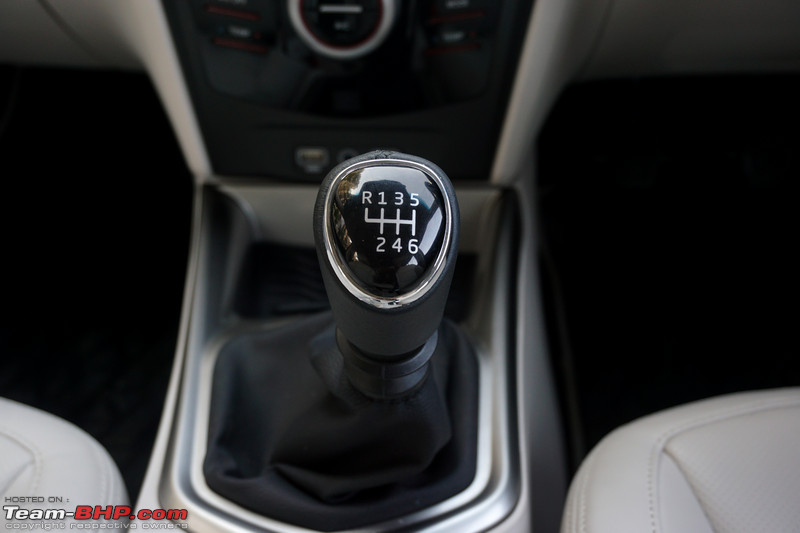 Gear lever has a leather boot. Reverse is engaged by lifting up that plastic collar:  Gearshift indicator has been provided. While the MID displays the current gear engaged, it momentarily flashes the gear that the car should ideally be in, with an arrow sign. Newbies will appreciate this feature:  The cruise control sign appears momentarily when the feature is activated or deactivated. The green indicator (in the speedometer) stays on as long as the function is activated:  Last edited by Aditya : 4th February 2021 at 17:59. |
| |  (38)
Thanks (38)
Thanks
|
| The following 38 BHPians Thank Aditya for this useful post: | @viral, akshay81, AYP, black.beauty, carrazy, ChiragM, Chrome6Boy, classiccurves, DevilzzzzOwn, espraveen, FrodoOfTheShire, GKMahajan, GTO, hiren.mistry, JoseVijay, lemedico, Lij, N33raj, Nohonking, PapaKiloSierra9, phoenixash, Ponbaarathi, RavenAvi, Sheel, Simat, Simhi, suhaas307, sunny29584, Swap_Abarth, swiftnfurious, The_Outsider!, timuseravan, uday.ere, vaasu, Varun_HexaGuy, vb-saan, vijit.gangwar, VTec_KickedInYo |
| | #8 |
| Team-BHP Support  | Driving the 1.5L Diesel MT 1.5L diesel is shared with the Marazzo. Developed in-house & puts out 115 BHP & 300 Nm:  The XUV300 is also available with a 1.5L, 4-cylinder diesel engine that has a variable geometry turbocharger. Like the petrol, this one is mated to a 6-speed manual gearbox. It's already been seen in the Marazzo MPV. However, in the XUV300, the state of tune is different. Here, it develops 115 BHP (@ 3,750 rpm) against the 121 BHP (@ 3,500 rpm) of the Marazzo. Its 300 Nm of torque is identical to the Marazzo’s, but it is produced at 1,500 - 2,500 rpm, while in the Marazzo, it is produced at 1,750 - 2,500 rpm. The XUV300 diesel produces more power and torque than all its direct rivals. In two words, this engine is also "damn good". With a kerb weight of 1,360 kg, the diesel has a power-to-weight ratio of 85 BHP / ton, which is higher than its rivals. The XUV300's torque-to-weight ratio of 221 Nm / ton is considerably higher than all cars in its segment too. Like the petrol, the diesel does not have an automatic variant at the moment. Diesel rivals like the Nexon and Vitara Brezza offer AMT variants. As a late entrant in this extremely competitive segment, we feel that the XUV300 should have come out all guns blazing to make an impact. That's usually how Maruti & Hyundai do it. To start the XUV300’s diesel engine, press the clutch and hit the engine start button. The diesel fires up with very little noise, and without transmitting any noticeable vibrations to the cabin. At idle, it is impressively refined. The clutch is light to press, although it has an annoyingly long travel range - real bummer in traffic. The gear shifter is light, but again, it has long throws for a car of this class. What is good is that its gates are well-defined and smooth. The usual rubbery feel that you find in Mahindra gearboxes isn't there. Release the clutch gradually and the car moves forward without any throttle input. In fact, with mild accelerator inputs, you can move off from a standstill in 2nd gear. The car even managed to clear a speedbreaker in 2nd gear from a standstill! Throttle response is good and the power delivery is acceptable. However, there is some lag at the absolute bottom end. Let the revvs drop too low, and the engine stalls (me & GTO both stalled it). There is no anti-stall feature and the engine dies out abruptly. You cannot be careless with the accelerator & clutch modulation. Other than this, the engine's driveability is satisfactory in the city. It pulls well once the revvs cross 1,500 rpm and when the turbo spools at 2,000 rpm, you'll experience a surge of power. Once you get used to the behaviour of the engine, the XUV300 is easy to drive in the city with its light controls, a tall seating position and good visibility. The only drawbacks are the long-throw gear lever & clutch pedal. On the open road, the XUV300's performance feels strong & there is ample grunt available. Work the XUV300 hard on the expressway and you can make fast progress. The mid-range is where the XUV300 is at its best. This 1.5L feels strong in the 2,000 - 4,000 rpm range. When pushed, the engine will revv to 4,750 rpm. However, there is no point taking it beyond 4,200 rpm as power delivery tapers off. The top-end isn't strong, with the engine getting noisy above 3,500 rpm too. In terms of cruiseability, the XUV300 will do 100 km/h & 120 km/h in 6th gear at 1,900 rpm & 2,300 rpm respectively. And even in 6th gear, the motor feels tractable. If you want to overtake, say from 100 km/h on the expressway, you don't need to downshift. It can be done in 6th gear itself. Only if the revvs drop too low will a driver feel the need to downshift. The W8 and W8 (O) variants are equipped with an idling start/stop system, which switches off the engine when it's idling to save fuel. It functions just like the petrol's, so you can refer to our comments in the post above. In a nutshell, we find it annoying! Maruti has made the feature a lot more seamless in its newer cars (e.g. Ertiga) & Mahindra needs to learn from that. Further, the Marazzo got an ECO mode which we'd much prefer over this idling start/stop nonsense, if we were looking at saving fuel. Coming to NVH levels, the XUV300's cabin is nicely insulated & the car is surprisingly refined. It feels more "Hyundai" than "Mahindra". Even the insulation from exterior / traffic sounds is good. Wind & tyre noise are both well-controlled at 100 km/h. The engine feels superbly refined and under regular driving conditions, it can hardly be heard inside the cabin. The motor starts getting loud only above 3,500 rpm. There is a faint buzz on the gear lever when the car is idling, but no one will notice this (except for a BHPian). The XUV300 diesel has an ARAI-certified fuel efficiency rating of 20 km/l. This puts it behind all the sub-4 meter SUVs in the market and way off the segment-leading 25.5 km/l of the WR-V. However, we must remember that the XUV300 is a much heavier car & has more power too. Diesel engine fully fills up the engine bay:  Engine has an aluminium oil sump. Good that a plastic engine cover has been provided...  ...because it's an ugly sight without the cover! This is among the most cluttered engine bays we've seen:  Underbody protection is satisfactory:  Indicator light glows when the idling start / stop system switches the engine off:  Last edited by GTO : 15th April 2019 at 11:04. |
| |  (46)
Thanks (46)
Thanks
|
| The following 46 BHPians Thank Aditya for this useful post: | @viral, akshay81, amit_purohit20, AutoIndian, AYP, black.beauty, carrazy, ChiragM, Chrome6Boy, DevilzzzzOwn, FrodoOfTheShire, GKMahajan, GTO, gunin, hiren.mistry, InControl, johannskaria, JoseVijay, lemedico, Lij, myavu, N33raj, nmenon, Nohonking, Omkar, PapaKiloSierra9, phoenixash, Ponbaarathi, RavenAvi, sayakc, Scorpion 10, shashanka, Sheel, shipnil, Simat, Simhi, spinningwheels, suhaas307, sunny29584, swiftnfurious, Thermodynamics, The_Outsider!, timuseravan, uday.ere, vaasu, Varun_HexaGuy |
| | #9 |
| Team-BHP Support  | Ride & Handling First, an important clarification. The first XUV300 test car we got was a poor handler (link). Turns out, the rear dampers / shock absorbers were defective (link). This affected most of the early XUV300s. So, if you bought one, be sure to have it checked up ASAP. Below are our observations after getting a properly functioning test car. ------------------------------------------------------ The XUV300 uses a ubiquitous MacPherson strut suspension with an anti-roll bar at the front and a twist beam at the rear. Low speed ride quality is compliant & mature. Small bumps are absorbed well, but keep in mind that Mahindra has raised this car compared to the Tivoli, so they would have to firm things up a bit. Plus, it runs on 17” wheels. There is a bit of a firm side to the ride which you will feel on bad roads & large potholes. Owners won't complain as it is overall compliant, but not plush. Equally, we might add that the suspension is more comfortable than most of its direct rivals (EcoSport, Nexon), yet not as good as the WR-V. The ride improves as the speedometer climbs. It is comfortable on the expressway. Must be noted that our test vehicle was running on 17" wheels, while lesser variants get 16" rims with taller rubber. The ride quality on those will be cushier. The suspension hardware functions silently too, with no unpleasant noises heard. Being a monocoque crossover, the XUV300 is car-like to drive. Owners will appreciate this in the city & on long journeys alike. Out on the highway, straight line stability is good, even well into triple digit speeds. It doesn't get bouncy over bumps or road undulations either. Grip levels are satisfactory and the car remains composed through fast corners. Some body roll is there, yet it's controlled and there are no scary surprises. That said, in the area of handling, the EcoSport remains the segment-best. The Mahindra does not have that absolute composure & poise of the Ford (I also found the EcoSport's steering to be the sharper one). As with all Mahindras, this one is rough-road friendly. You won't see yourself slowing down for rough patches, broken bits of road or dirt tracks. The XUV300 feels abuse-happy and there's a certain ruggedness evident when tackling rural roads. The grip provided by our petrol car's 215/55 MRF Wanderer tyres was decent, though not exceptional. Interestingly, our diesel test car came with Apollo Alnac G4 rubber, which was certainly grippier. The XUV300 gets an electric power steering with 3 selectable modes – Comfort, Normal & Sport. These modes can be engaged via a button on the center fascia. The vehicle remembers the mode that was chosen, even after a restart. Comfort mode - The steering is one-finger-light at parking speeds and does not require any effort to turn! In fact, it reminds me of Hyundai steerings. It is that light. This mode is excellent to use in the city where speeds are very low. Normal mode – The steering is still light, but not as much as in Comfort mode. It can still be used in the city and to some extent, on the highway as well. It's neither here nor there, frankly. Sport mode – Our mode of choice for highway runs. The steering has noticeably more heft here. On the downside, the steering needs proper calibration. We don't know why, but Mahindra never gets its steerings right. We found the steering to be too sensitive at high speed, especially in Comfort & Normal modes. Always remember to firm up the steering by putting it in Sport mode. The XUV300 has a turning radius of 5.3 meters, which is wider than the Nexon's 5.1 meters and the Vitara Brezza's 5.2 meters. Conversely, the unladen ground clearance is rated at 180 mm, which is lower than all its rivals. Still, 180 mm is enough and we didn't scrape the undercarriage anywhere. Not even on the rough patches we put the car through for photography. All variants of the XUV300 come with all-wheel disc brakes, ABS + EBD and corner braking control (top variants further get ESP, rollover mitigation & hill-hold). The stopping power is adequate even when slowing the car down from high speeds. While the brake pedal travels very little before the pads start biting, it feels spongy & mushy (again, a Mahindra trait). The brakes do feel over-servoed and you'll take a couple of km to get used to their bite. EPS gets 3 modes to choose from. Golden rule is, Comfort = City, Sport = Highway:  Last edited by GTO : 15th April 2019 at 09:52. |
| |  (42)
Thanks (42)
Thanks
|
| The following 42 BHPians Thank Aditya for this useful post: | @viral, Added_flavor, akshay81, ampere, arbaz906, AYP, carrazy, ChiragM, DevilzzzzOwn, Dr.AD, espraveen, FrodoOfTheShire, GTO, InControl, JoseVijay, Keynote, lemedico, Lij, myavu, N33raj, Nohonking, PapaKiloSierra9, phoenixash, Ponbaarathi, PrasunBannerjee, RavenAvi, Scorpion 10, Sheel, Simat, Simhi, spinningwheels, suhaas307, sunny29584, swiftnfurious, The Rationalist, The_Outsider!, timuseravan, uday.ere, vaasu, Varun_HexaGuy, vb-saan, vijit.gangwar |
| | #10 |
| Team-BHP Support  | Other Points • Built at Mahindra's Nashik production facility and not the more modern Chakan factory. We're surprised! • At least 5 people who asked us about the car during our test-drive discounted the XUV300 from their shopping lists due to the lack of an automatic transmission. A missed opportunity. AMT is coming soon. Apparently, it’s just a temporary fix while a proper torque-converter AT is developed. • The SsangYong Tivoli was imported for research back in October 2015. First spotted testing in India in December 2015. Caught with Mahindra-spec bodywork in November 2018. • An electric version of the XUV300 is rumoured to be coming in 2020. About time Mahindra did something with EVs! It bought Reva years ago and still has nothing really to show for it. So much for a first-mover advantage. • Under panic braking conditions, the hazard lights will start flashing to warn those behind. • Mahindra knows that the boot will be a deal-breaker for many. Its showrooms actually have luggage demonstrations! Click here to view BHPian Sherlocked's post. • Available in 4 trim levels - W4, W6, W8 & W8 (Optional Pack). Even the W6 has a lot of stuff missing. The pricey W8 variants are the only ones we recommended. Mahindra should kit out the W6 properly for those on a lower budget. Middle variants are very, very important. • Doors auto-lock at 20 km/h. All doors unlock when the engine is switched off. Weirdly, all doors also unlock when any of the front doors is unlocked. As much as we're fans of auto-locking, we hate any kind of auto-unlocking. Our country is too crime-prone for that. • Service interval = 10,000 km / 1 year. Labour-free services are at 1,000 km (just a checkup I'm guessing), 10,000 km and 20,000 km. Yes, the XUV300's MID will remind you when the service is due. • Standard warranty coverage is for 2 years / unlimited km. Extended warranty available for up to 5 years / 150,000 km. Don't even think twice; considering that the car, engine & transmission are all new, just go ahead & pick up the extended warranty with your eyes shut. If still in doubt, read this 300-page thread. Not to forget, our test car itself had a defective rear suspension! • Mahindra is providing roadside assistance to all new XUV300s for a period of 2 years from the date of sale. • The SsangYong Tivoli is sold with an optional AWD. We're surprised that Mahindra – the king of offroaders in India – isn't offering the AWD here. Would suit its brand image to have the XUV300 AWD in the showroom. • Mahindra plans to export the XUV300 to Europe, South America, South Africa, Sri Lanka, Nepal, Australia and New Zealand. Left-hand drive versions will be ready soon. • The Mahindra XUV300 brochure can be viewed here - Mahindra XUV300.pdf. • Disclaimer: Mahindra invited Team-BHP for the XUV300 test-drive. They covered all the travel expenses for this driving event. Last edited by GTO : 15th April 2019 at 09:51. |
| |  (45)
Thanks (45)
Thanks
|
| The following 45 BHPians Thank Aditya for this useful post: | @viral, aadya, Abhinav_2502, amit1agrawal, amit_purohit20, arbaz906, AutoIndian, AYP, carrazy, ChiragM, Chrome6Boy, DevilzzzzOwn, Dr.AD, espraveen, FrodoOfTheShire, GKMahajan, GTO, hiren.mistry, InControl, johannskaria, JoseVijay, lemedico, Lij, N33raj, PapaKiloSierra9, phoenixash, Ponbaarathi, PrasunBannerjee, RavenAvi, sayakc, Scorpion 10, Sheel, Simat, suhaas307, sukiwa, sunny29584, supertinu, swiftnfurious, The_Outsider!, timuseravan, uday.ere, vaasu, Varun_HexaGuy, vb-saan, vijit.gangwar |
| | #11 |
| Team-BHP Support  | The Smaller yet Significant Things A look at the more practical black seat upholstery of the lower variants:   Apart from the Sunburst Orange colour seen on our test car, the XUV300 is available in 5 other shades. These include Red Rage, Aquamarine, Pearl White, Napoli Black and D-Sat Silver. Two of these shades are available with a white roof. Here is the Aquamarine + White combo... 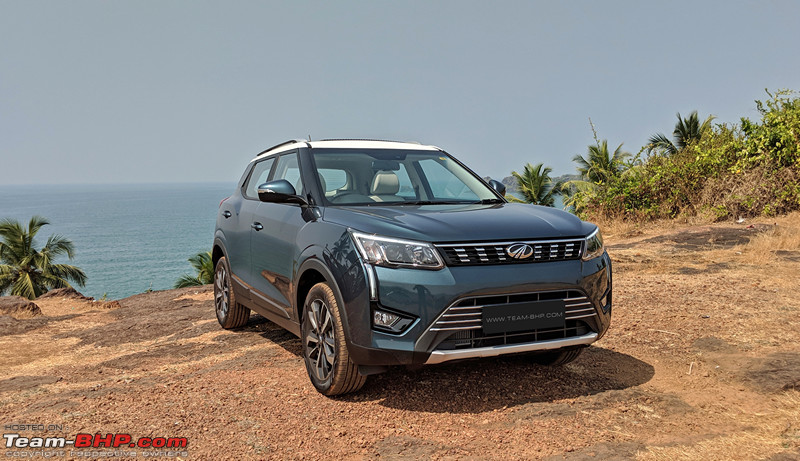 ...and the Red Rage + White combo. These dual-tone versions are available only in the W8 (O) trim and cost Rs. 15,000 more than the single-tone versions. This Red + White was a hit with the ladies:  While our petrol test car was shod with MRF Wanderer tyres, the diesel sported Apollo Alnac 4G rubber:  Partial cladding in the front wheel well...  ...and full cladding in the rear:  Both engine variants get their dietary preferences marked on the fuel cap. A small plastic hook is provided on the inner side of the fuel flap...  ...to hold the cap while fueling:  42L fuel tank is a couple of liters smaller than all of the XUV300's direct rivals, except the Honda WR-V (40L):  No LED headlamps, yet the halogen projectors do a good job of lighting up the road ahead:  With the high beam engaged, the throw is just average. Could have been better:  Recommended pressure of 34 PSI for the 17" rims is on the higher side. 16" variants have a 32 PSI rating:  Rubber beading is soft, of good quality and well-fitted. Cabin insulation is very good:  Driver’s footwell gets 2 hooks to hold the floor mat in place. Don't miss the contrast-white branding on these mats:  Flippy key looks and feels premium. Lowest button is for "SOS" or locating your car in a crowded parking lot:  Volume button got stuck frequently on our test car. Mahindra needs to figure how to sort these niggles out. Three problems on our test car (rear shock absorbers, air-con cooling & this button):  A system check is performed every time the car is started. The speedometer and tachometer needles do a clean sweep as well:  While the engine start button is backlit in white...  ...the other switches are backlit in orange: 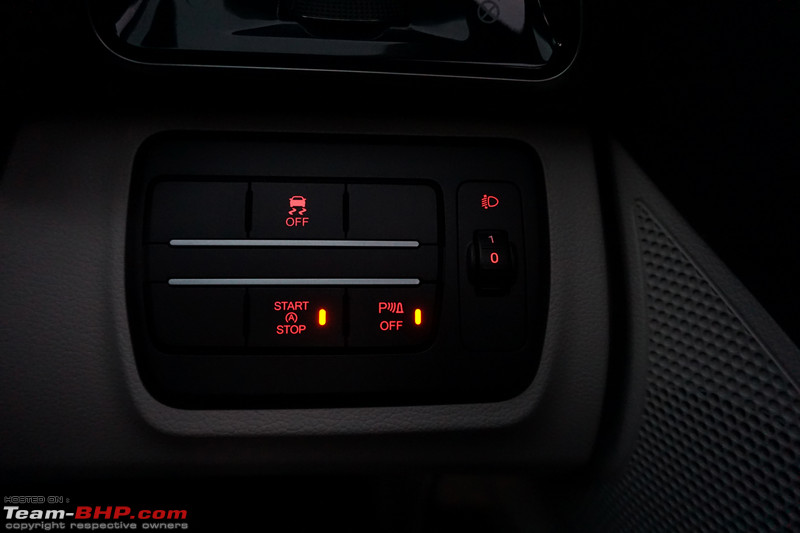 USB and AUX ports are backlit in white. Storage space below them gets orange lighting: 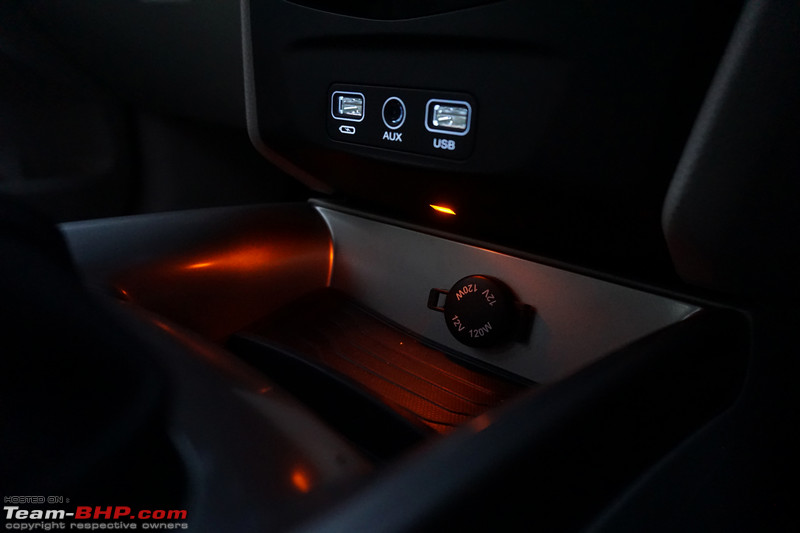 Orange ambient light strips are provided on all 4 doors (below the armrests):  Front seatbelt buckles get a soft lining to prevent them from scratching / making a noise when rubbing against the center console:  If any of the 3 rear passengers hasn't buckled up, the seatbelt reminder light blinks all of 33 times before going off. We like this. In the update, Mahindra should add a non-stop chime to force them to buckle up:  Soft foam insulation, just behind the radiator grille. I remember seeing this in the Verna:  Headlamp clusters get a unique rubber strip on top:  Last edited by GTO : 17th April 2019 at 12:34. |
| |  (78)
Thanks (78)
Thanks
|
| The following 78 BHPians Thank Aditya for this useful post: | 2himanshu, @viral, aadya, Abhinav_2502, akshay81, amarendernag, ampere, anumod, arbaz906, asingh1977, AutoIndian, AYP, BoneCollector, brohanv, carrazy, catchjyoti, ChiragM, Chrome6Boy, Desmosedici, DevilzzzzOwn, Duckdoc, espraveen, FrodoOfTheShire, GKMahajan, GTO, hdman, hiren.mistry, InControl, IndigoXLGrandDi, isandy, jailbird_fynix, joe_lightspeed, johannskaria, JoseVijay, Keynote, knightrider_7, lemedico, Lij, LoneRidder, myavu, N33raj, Nohonking, Omkar, PapaKiloSierra9, phoenixash, Ponbaarathi, PrasunBannerjee, predatorwheelz, RaghuVis, ramgkulkarni, RavenAvi, Ravi Parwan, Rocky_Balboa, Safari_Beast, sayakc, Scorpion 10, sharktale, Sheel, Simat, Simhi, spinningwheels, ssoni.1411, suhaas307, sunny29584, Swap_Abarth, swiftnfurious, Tech_Driver, Thermodynamics, The_Outsider!, timuseravan, traV_mach, uday.ere, vaasu, Varun_HexaGuy, vb-saan, VeluM, vijit.gangwar, VTec_KickedInYo |
| |
| | #12 |
| Team-BHP Support  | Re: Mahindra XUV300 : Official Review Thread moved from the Assembly Line to the Official Reviews Section. Thanks for sharing! Superb, detailed & unbiased review, Addy. Rating thread a full 5 stars  . . Mahindra really impresses with the quality, build, refinement, fit and finish of the XUV300. In so many ways, it feels more like a mini-Creta than a Mahindra. And the company is smart. The Indian market has now matured to a level where customers are willing to pay a premium for top quality. That said, I wish they'd done an "XUV500" with the pricing, at least in the initial period. When the bigger Mahindra was launched, it led to jaws being dropped. Not the case with the XUV300. While I personally don't find it overpriced (keeping the quality & equipment levels in mind), I do know that some BHPians do. The lack of a proper mid-variant only complicates matters further. I expect Mahindra to release a W6 (O) or W7 variant. Lovely engines as well. As someone who prioritises engine performance & driveability over all other factors, I enjoyed driving the car. Last edited by GTO : 15th April 2019 at 10:20. |
| |  (43)
Thanks (43)
Thanks
|
| The following 43 BHPians Thank GTO for this useful post: | Aditya, amit1agrawal, ampere, arbaz906, AutoIndian, CarCynic, Cartik5477, catchjyoti, chiefpk, ChiragM, Chrome6Boy, DrANTO, Duckdoc, espraveen, FrodoOfTheShire, InControl, JoseVijay, jvm_1986, Keynote, Lij, N33raj, nmenon, Nohonking, PrasunBannerjee, rainmaster, RavenAvi, Safari_Beast, sayakc, Sheel, shipnil, ssoni.1411, suhaas307, sukiwa, swiftnfurious, The Rationalist, Thermodynamics, The_Outsider!, uday.ere, vaasu, Varun_HexaGuy, vb-saan, VeluM, VTec_KickedInYo |
| | #13 |
| Senior - BHPian Join Date: Mar 2017 Location: BLR
Posts: 1,272
Thanked: 8,816 Times
| Re: Mahindra XUV300 : Official Review |
| |  (8)
Thanks (8)
Thanks
|
| The following 8 BHPians Thank AMG Power for this useful post: | Aditya, Chaman K, GTO, RavenAvi, swiftnfurious, The Rationalist, vb-saan, VeluM |
| | #14 |
| Senior - BHPian Join Date: Apr 2008 Location: Bangalore
Posts: 1,612
Thanked: 2,552 Times
| Re: Mahindra XUV300 : Official Review The official review more or less confirms the initial conclusions that I drew when I test drove both petrol and diesel variants in February, just after launch- that the XUV 300 is more suited for the open road and expressways than city drivability. City driving is pretty average for engines which boast of segment best power and torque specs. The diesel, particularly, is spunky only after 2000RPM below which it is fairly average in terms of power delivery. For someone like me, who drives mostly in the city and at RPMs below 2500 most of the time, these engines do not make to much sense (especially given the high premium that they command over direct competitors). If my highway usage was substantial, this car would have ben a strong contender. |
| |  (3)
Thanks (3)
Thanks
|
| The following 3 BHPians Thank arindambasu13 for this useful post: | Aditya, gb97ce6, RavenAvi |
| | #15 |
| BHPian Join Date: Jul 2013 Location: MH 12 / KL 08
Posts: 794
Thanked: 2,110 Times
| Re: Mahindra XUV300 : Official Review Lovely review addy. The car too gets a thumbs up from me. It's Mahindra's XUV 500 moment of sorts. The market is ready for it and boy it delivers on all points except for an automatic transmission. Even the AMT is not a full-fledged solution for such a powerful and well-rounded XUV300. Mahindra is surely on a roll. A good Alturas, well rounded XUV 300 and a modern touch for the legendary Thar. Hopefully their EV division too catches up and redefine/innovate the EV market in India. Absolutely loved the DRL implementation. 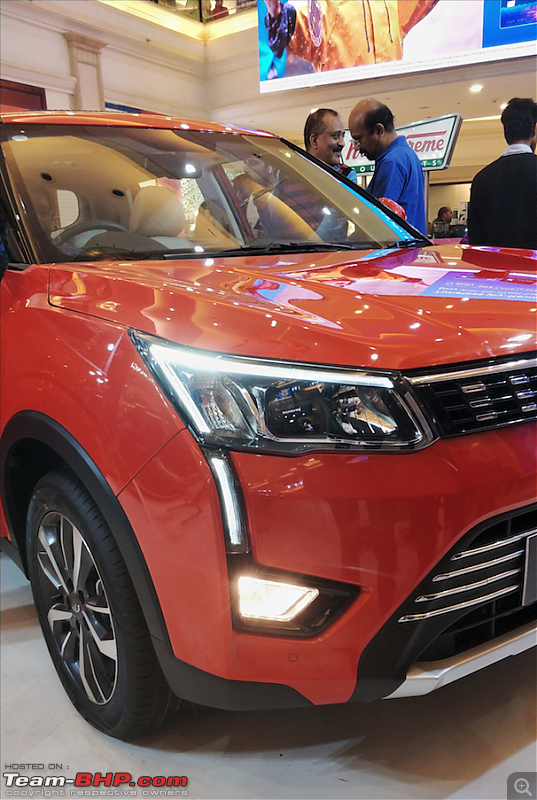 I see this design aging well 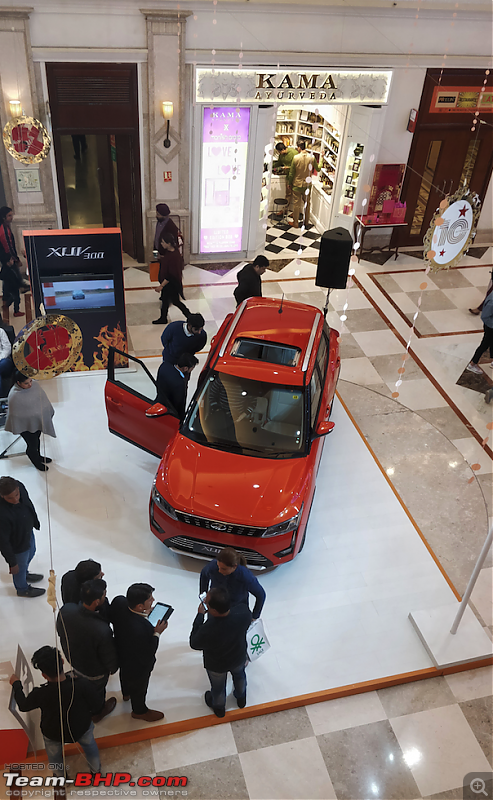  Last edited by johannskaria : 15th April 2019 at 11:31. |
| |  (20)
Thanks (20)
Thanks
|
| The following 20 BHPians Thank johannskaria for this useful post: | Abhinav_2502, Aditya, AutoIndian, ChristComesSoon, cn.vishnu, driving_smartly, ganeshb, GTO, InControl, JoseVijay, lemedico, PrasunBannerjee, RavenAvi, suhaas307, swiftnfurious, The Rationalist, uday.ere, Varun_HexaGuy, VTec_KickedInYo, WindmillsFly |
 |



